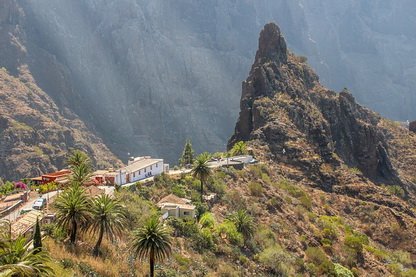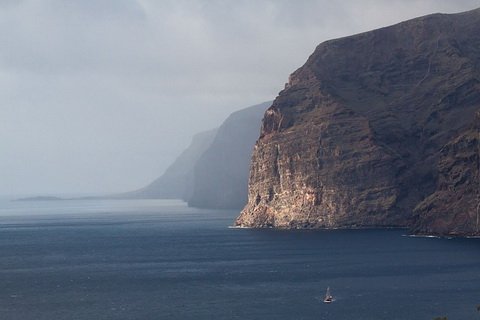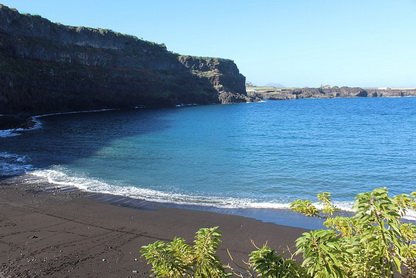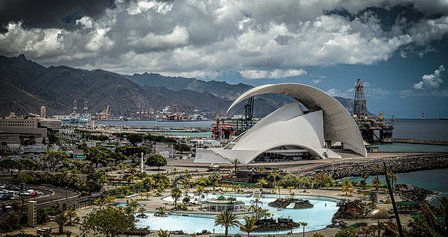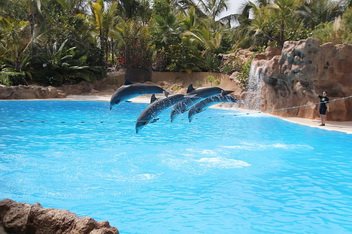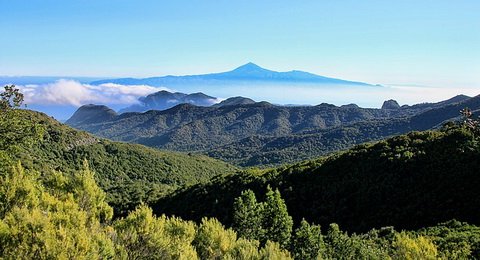Main attractions – Tenerife
View on the map
Nature
1 Masca – 2 Cliffs of the Giants – 3 Teide – 4 More… – 5 Beaches
Other
The Canary Islands treat themselves as one, but for obvious reasons they are divided. Because of this each of the islands has its own set of attractions. But when you look at them, you can group them into the same categories. We have nature’s wonders, which are by far the best attractions of the Canary Islands! Then you have Instagram beaches, lovely towns, museums, fun-places, and day tours.
Follow these few articles and choose the best option for you.
1 Masca
Hidden gems may still be found… It is easy to believe, especially, after learning that the Masca village was discovered as late as 1991. Even today it is tiny – it has about 90 permanent inhabitants. It is hidden away on the slopes of the Masca Gorge. This strain of mountains goes directly from the Teide Volcano to the shore.
The road to the village is not for those of a faint heart. It winds with the ancient lava flows that shaped the terrain. There are a lot of sharp turns and a lot of busses to pass (mostly in the tourist periods). If you decide to drive there by yourself be prepared for some chilling experience (we recommend getting there before 11). But then…
Imagine a gorge covered in a green carpet of cypress trees, palms, and bushes. With the morning mist or evening glow, it turns into this forgotten land that you have only imagined or dreamt about. The village is a colorful speck, full of flowers and it seems stopped in time. It offers great views, which you can now, after arriving, finally enjoy.
Until 2018 there was a trail that led from the town to the shore. It was a difficult walk that lasted 3h one way. But the faces of nature you saw on the way were worth it. The vastness of the ocean that you saw at the end of it, promised the wonders of the New World… You also got to see Acantilados de los Gigantes or take the boat around them and go to shore in another place. It was a nice one-day trip – bus to Masca, trekking down, boat to Los Gigantes town. And bus back to the hotel.
The trail is still closed. It was too difficult, and the government decided to adjust it. They still have not finished.
2 Cliffs of the Giants (Acantilados de Los Gigantes)
They invoke all kinds of feelings, especially when you are traveling on a boat alongside them. They are one of the tallest in Europe – ranging from 650 to 800 meters. It was the Teide Volcano that created them. Then raging sea took dominion of them.
Today the basalt rocks stand as protectors to a tiny village called Los Gigantes. It is sometimes swarming with tourists. Is it really a giant sleeping there, protecting the inhabitants? Or is it the Wall of the Devil like the Guanches once said?
Decide by yourself. They are seen from every corner of the village, which also have some miradors – viewpoints. The walls of black and red, standing one by one like soldiers in the army – calm with the calm weather or mysterious in the clouds of water and mist.
Then you can enjoy your day on a beach or in the town, before continuing your journey. And if you have a car – try Punta de Teno viewpoint. The Giants are breathtaking from there.

3 Teide
Teide National Park is the oldest and the largest of all the parks in the Canary Islands. It was declared a UNESCO site in 2007. Long before that, the peak of the Teide Volcano was inspiring people to climb on it. Even before that, it was both a silent guardian and the prison of the devil for the local Aborigines.
Legend, nature, and stories create the area. Legends tell you about forgotten Atlantis. They create stories out of the numerous archaeological artifacts connected to ancient rituals. Nature is the creator, making Teide out of 3 stratovolcanoes. It now rises to 3718 meters above sea level and, regardless of the scorching sun, it has snow in winter. The one-of-a-kind climate created local species of fauna and flora and all can be seen on a tour to the “Teide Plateau”.
Tourists can get as high as to 3500 above sea level with a cable car and go on one of 3 hiking trails from there. There is a possibility to book a tour of a park, to do some stargazing and to drink cava at the sunset. The stories do not end there. Teide volcano literally overshadows the rival of Tenerife (Gran Canaria)! Last, but not least – it still invokes prayers. You are visiting a volcano that may erupt one day.
4 More of NATURE
The natural wonders of Tenerife are numerous. The Island is desert-like in the south and wonderfully green in the North. You get an impression of being in another world that has everything on it – starting with the mountains and going down to the sea.
One of the many green wonders of the area is the Anaga Forest (4a). It is situated in the far north of the island. It creates a jungle with lianas that you would not expect in this climate. It takes its name from the mountains and ravines it is situated in. Laurel trees, winding paths, some visitor centers, and the coastline create together a possibility for a lovely walk. You may visit it on your way to one of the most beautiful, Instagrammed beaches in the Canary Islands – the Benijo Beach.
As for her sisters, you will also find caves here. These are called Cuevas del Viento (Wind Caves – 4b) and offer a two-hour tour into the cold belly of Tenerife. It is one of the longest underground mazes, but you do not have to walk all 18 kilometers (no worries)!
5 Beaches
One of Tenerife’s wonders is black sand beaches. Unless you do not know already – this is the effect of the erosion of the volcanic basalt rocks. Depending on the degree, they can feel like walking on gravel and some swimming shoes are recommended. But there is also the black equivalent of the soft, white sand.
On Tenerife, you can find both. Roughly put – the SE area is the normal sand, and the NW is the black one (on the photo – Playa Garachico). Not only the color of the sand makes the beaches of Tenerife famous. Everyone knows that coming to the Canary Islands means relaxing and having fun. There are beaches for sun-lovers, wind-lovers, picture-takers, solidarity-seekers… a little bit of everything.
Some of the major spots you will find throughout the Internet are:
- Las Vistas Beach (Los Christianos)
…everything is there starting from water sports and finishing with a shopping center. Delicate sand and a popular spot of the south make it a bit crowded
- Puerto Colon Beach or Playa de Duque
…go there in search of a calmer place but still a tourist resort. Costa Adeje has something for everyone
- El Medano
…a beach for the sport and wind lovers. With the atmosphere that goes with it. There is a lovely, not too big, beachfront with some bars and shops there too
- Playa de los Teresitas
…Sahara sand, the man-made beach of the capital
- Playa Jardin and Martianes
…walk through the first to get to the other. Playa Jardin (photo above) is the heart of Puerto de la Cruz and a good place for a day spent at the seafront next to a city
- Playa Benijo
…black sand, secluded and with sunsets. This is a spot for the photographers
- El Bollullo
…close to Puerto de la Cruz, black sand, relatively calm
From big to small – beaches in Tenerife come in a great variety. There are tiny places accessible only by stairs in a rock. Standing at the edge of the cliff you would have never thought that there is a beach under your feet. Those are the least visited beaches. There are bathing spots and relaxing spots. There are water pools or piers. Follow the locals, because they know where the road to the water is.
6 Santa Cruz de Tenerife
The capital of the island may interest you if you are looking for local history. It has museums of many sorts – anthropological or historical (try the Museum of Nature and Man). What may be more interesting – you will learn about the Carnival there.
Although people are known to live in the area since the times of the Guanches, the city was created by the invaders. The end of the XV century is the beginning of the conquest, and the place where the cross was first put, became a town. Today it grew to be one of the best places to live – according to the Guardian newspaper.
There is a great beach there, made with sands brought from Sahara (Los Teresitas) and the Anaga forest is right next to it. The city has a rich nightlife and plenty to do throughout the day. Its most visited place is the Auditorium, sitting just next to the main plaza with an artificial lake in it. The shape of the Opera House is one of a kind. It is just perfect to sit there with a coffee and enjoy the scenery. Santa Cruz may not contain a lot of typical, Canarian architecture, but it is an interesting, modern, island town.
7 Other TOWNS
Tenerife has 1 million of permanent inhabitants. Most of them are in the capital, but there are still a lot of places to live in. You already know Masca – but this is only a tiny example.
Right next to Santa Cruz de Tenerife lies a picturesque San Cristobal de Tenerife (NE – 7a)(adjacent photo). There is a reason why UNESCO put it on a list. If you want to experience the colonial times, go there. A city is filled with XVI-XVIII centuries architecture. It is adorable! – like walking in Paris or Lisbon. There is also a Museum of History and Archaeology there.
Try Garachico and Icod de los Vinos (W – 7b) – they are close to each other. You will love the first for its minuscule charm and the other one for its Dragon Tree (in the photo). You do not need to pay and go to see it from up close. It is perfectly visible from the town square. A century-old tree, as they say, is the national monument of Tenerife. But you will know why when you see it with your own eyes.
Orotava is not far from Puerto de la Cruz (NW – 7c). It is an inland town, and it seems “nothing special”. But somehow it is different from the coastal ones. It has a great example of local architecture and a town that grew, even far away from the coast. It’s Casa de los Balcones is an iconic, Canarian building turned into a museum. You will also enjoy the Festival of Wine, which is a glorious and colorful celebration. If you time it right, you can enjoy the parades in different cities of the region for the whole week! Wine too…
8 Having fun on Tenerife
The Canary Islands are a tourist destination. For them and for the locals, Tenerife created some interesting places to enjoy themselves.
There are a few botanical gardens with some endemic plants that you will not see in other parts of the world. It is thanks to this specific climate and the variety of latitudes.
The theme parks include the wonderful zoo-like park called Loro Park and Jungle Park – something for those coming to Tenerife with kids.
Siam Park is a Thai-style aquapark in the south of the island. It has its smaller sibling – Aqualand (on Costa Adeje), which is dedicated to children. Some of the bigger park’s attractions may be too thrilling for them.
The seekers of curiosities can find the Pyramids of Guimar (man-made in the XIX century) in an etnopark on the E-coast. They are so surprising and so out of place, that this made them an attraction!
Whale and dolphin watching is forever popular both because of the animals and spending some time on a boat.
There is also a range of activities to choose from like: kite surfing, paragliding, jet skiing or simply experiencing the local nightlife (Pyramide de Arona on Costa Adeje is an auditorium with various shows – try the flamenco one). Do not forget about the Carnival and local festivals (like the Wine Festival in Orotava) – they are a mixture of local culture, customs, and a lot of fun.
9 Day tour to La Gomera
The province, that Santa Cruz de Tenerife takes care of, expands to the smaller islands of the western side of the archipelago. One of the islands easiest to visit from Tenerife is La Gomera. The majority of day tours part take a boat from Los Cristianos (even airports have a direst bus line with the pier). This is, to our knowledge, the easiest way to visit.
On a jeep or a mini-bus tour, you will be taken by the local guides to see all the most interesting attractions of this secluded island. It can be described as a mountain with ravines that are home to small, colorful towns (a lot of viewpoints along the way). The Ancient forest of Garajanay (on the photo) was created in prehistoric times and survived, untouched, due to the remoteness of La Gomera.
This island is also a place where a whistling language was created (the only one in the world). Some tours offer a presentation of this curious way to speak. But then – having the largest “organs” in the world, it may not be that surprising. Try to look for a boat excursion to Los Organos Natural. Vertical, basalt tubes stick out of the ocean and start deep beneath the surface. Looking at the cliff you are waiting for them to play a song. Trips tend to take place from Valle Gran Rey and Playa de Santiago.

